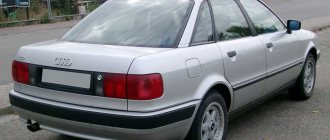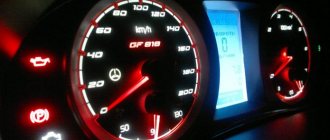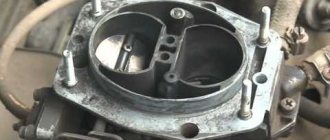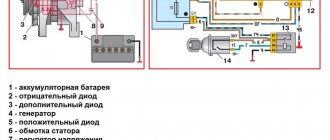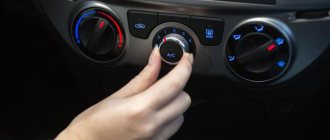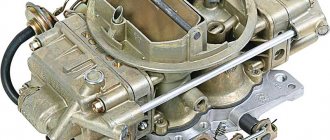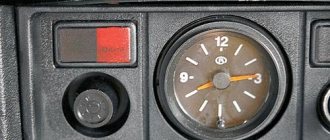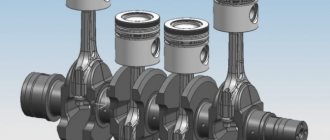Why do you have to adjust the idle speed?
For proper adjustment, you need to know how to adjust idle operation. If everything is done correctly, the procedure will not take much time. However, to do this you need to understand how the carburetor works and how it works. The main trouble associated with this problem is not the lack of idle speed, but the fact that the engine cannot operate stably and stalls.
Why can't the engine hold idle?
If the engine does not hold idle, first, you need to check the solenoid valve. However, it is not installed on all types of carburetors used in the VAZ 2106. If it is, then most often the problem is hidden in it.
In its operation, the valve is similar to a starter solenoid relay, it is even designed in the same way: there is a winding, a spring, a stator, but the overall dimensions are much smaller. The solenoid valve is needed to open fuel access when the throttle valve is in the closed position (gas pedal released). When the ignition is turned off, the valve should block fuel from reaching the carburetor.
Malfunctions of the solenoid valve that cause problems with stable idle speed include the following breakdowns:
- the winding is broken, the rotor does not move, and fuel does not enter the float chamber;
- the fuel nozzle is clogged with dirt;
- the rotor is deformed and jammed.
There is no need to contact specialists to diagnose valve problems. To check, just take a piece of wire and strip it from both sides of the insulation. One end of the wire must be connected to the positive terminal of the battery, the second is connected to the contact of the solenoid valve. There should be a click when connected. If this does not happen, the valve is faulty and should be replaced. There was a click - then you need to remove the wire and turn on the ignition, and then connect the terminal block to the valve terminal. If a click is not heard, this indicates a wire break in one of the sections of the circuit.
There are three ways to solve a problem with a faulty solenoid valve.
- If the valve is destroyed, you need to, firstly, unscrew it, and secondly, remove the fuel nozzle. This way you can get to the nearest auto parts store and buy a new valve. It costs mere pennies (no more than a hundred rubles).
- If the wiring is broken in a section of the electrical circuit, you can connect the valve output to the positive terminal of the battery using a wire and then drive to the store.
- The most effective temporary solution is to connect the valve contact using a suitable wire to the ignition coil contact. This way, voltage will be supplied to the valve only when the ignition is turned on. When the ignition is turned off, the valve will close.
If the problem is not the solenoid valve
Problems with idle speed can also occur due to low-quality fuel, a malfunction of the ignition system, or dirt. These factors appear both separately and together. Idle speed may become unstable or disappear completely. If you decide to diagnose the problem globally, then it is better to start troubleshooting by checking or replacing the air and fuel filters (including the fine filter on the fuel pump). If there is heavy contamination, the fuel-air mixture will flow into the carburetor intermittently.
You should also pay attention to the filter installed at the mixture inlet to the carburetor. If there is contamination, the filters must be replaced
If the problem XX still remains, it means that the search circle is expanding significantly. The next step is to check the spark plugs. If the spark plugs were last changed more than 30,000 km ago, they must be replaced. You should pay attention to the carbon deposits, or more precisely, to its color. If the service life has expired, the gap between the electrode and the spark plug will increase due to severe wear. After replacing the spark plugs, you need to check the stability of the idle speed again.
If replacing the spark plugs does not help, then you should check the ignition system. For a contact system, first of all, the breaker gap (slider) is measured and the correct ignition timing is set. In the case of a contactless system, you need to check the serviceability of the switch and Hall sensor. As a rule, these parts fail first, although nothing else can break there.
It would be a good idea to inspect high-voltage wires. If they are wet or dirty, they should be wiped down and inspected for damage, as well as checking that the insulation is intact and that there is no loss of spark. You can also inspect the distributor cover; it should not be damaged. And finally, you can measure the resistance of the resistor on the breaker; it should be within 5.5 kOhm.
Fuel system malfunction
The operating principle of the VAZ 2112 fuel system is not much different from similar vehicles with an injection system. Often the problem is purely mechanical - the fuel pump mesh becomes clogged.
Which leads to the impossibility of supplying fuel at the required pressure to the combustion chamber. A clogged fuel pump strainer looks like this:
An important factor in the operation of a car engine is the general condition of the fuel system. If the car does not start or does not grip well, or constantly stalls, the problem may lie in the incorrect operation of the injector ramp. The check is quite simple and you can do it yourself:
- open a special plug - it is black, located at one end of the ramp;
- the presence of pressure is determined simply - just bring your hand to the hole.
It often happens that there is pressure in the ramp. But the car continues to have difficulty starting. In this case, it is worth moving on to the next step - checking the operation of the fuel pump. Sometimes the problem lies in the carburetor. It is difficult to find VAZ 2112 cars with such an injection system on sale. If starting is difficult when cold, then the problem most likely lies in the electrics.
VAZ-2109 does not start - what to do?
In general, diagnosing malfunctions of the controller (computer) and control system sensors, as well as the VAZ-2109 injector itself, is not much different from similar work for other cars. But due to the peculiarities of the “nine” control system, experienced owners of this car recommend the following solutions.
Most often, the injection “nine” does not start in winter. In this case, it is advisable to warm up and even recharge the battery - perhaps due to loss of capacity due to low temperature, it is not able to spin the engine shaft well.
Another “folk” method that helps is supplying air to the engine filter through a hairdryer. At the same time, heated air will flow into the cylinders. Many people claim that the VAZ starts right away.
Another possible reason: as a result of prolonged unsuccessful attempts to start, the spark plugs were filled with gasoline. In this case, it is recommended to try to start the car with the gas pedal pressed all the way to the floor - the spark plugs should dry out and the car will start. If this does not help, then unscrew the spark plugs and check for the presence of a spark. If it is not there, then either the spark plugs or the ignition system are faulty.
Motorhelp.ru engine diagnostics and repair
Typical operating parameters of VAZ injection engines.
For many novice diagnosticians and ordinary car enthusiasts who are interested in the topic of diagnostics, information about typical engine parameters will be useful. Since VAZ car engines are the most common and easiest to repair, we’ll start with them
What should you pay attention to first when analyzing engine operating parameters?1. Engine stopped.1.1 Coolant and air temperature sensors (if equipped)
The temperature is checked to ensure that the readings correspond to the actual engine and air temperatures. It is better to check using a non-contact thermometer. By the way, one of the most reliable in the injection system of VAZ engines are temperature sensors.
1.2 Throttle position (except for systems with an electronic gas pedal). The gas pedal is released - 0%, the accelerator is pressed - according to the opening of the throttle valve. We played with the gas pedal, released it - it should also remain 0%, while the ADC with a dpdz of about 0.5V. If the opening angle jumps from 0 to 1-2%, then as a rule this is a sign of a worn out valve. Less common are faults in the sensor wiring. With the gas pedal fully pressed, some units will show 100% opening (such as January 5.1, January 7.2), while others such as Bosch MP 7.0 will show only 75%. This is fine.
1.3 MAF ADC channel in rest mode: 0.996/1.016 V - normal, up to 1.035 V is still acceptable, everything above is already a reason to think about replacing the mass air flow sensor. Injection systems equipped with feedback from an oxygen sensor are able to correct, to some extent, incorrect readings of the mass air flow sensor, but there is a limit to everything, so you should not delay replacing this sensor if it is already worn out.
2. The engine is idling.
2.1 Idle speed. Typically this is 800 - 850 rpm with a fully warmed up engine. The idle speed value depends on the engine temperature and is set in the engine control program.
2.2 Mass air flow. For 8-valve engines, the typical value is 8-10 kg/h, for 16-valve engines - 7-9.5 kg/h with a fully warmed-up engine at idle. For the M73 ECU these values are slightly higher due to a design feature.
2.3 Length of injection time. For phased injection, the typical value is 3.3 - 4.1 ms. For simultaneous – 2.1 – 2.4 ms
Actually, the injection time itself is not as important as its correction
2.4 Injection time correction factor. Depends on many factors. This is a topic for a separate article, but it’s worth mentioning here that the closer to 1,000 the better. More than 1,000 means the mixture is further enriched, less than 1,000 means it is leaner.
2.5 Multiplicative and additive components of self-learning correction. A typical multiplicative value is 1 +/-0.2. The additive is measured as a percentage and should be no more than +/- 5% on a working system.
2.6 If there is a sign of engine operation in the adjustment zone, based on the signal from the oxygen sensor, the latter should draw a beautiful sinusoid from 0.1 to 0.8 V.
2.7 Cyclic filling and load factor. For “January” typical cyclic air consumption: 8 valve engine 90 - 100 mg/stroke, 16 valve engine 75 -90 mg/stroke. For Bosch 7.9.7 control units the typical load factor is 18 – 24%.
Now let's take a closer look at how these parameters behave in practice. Since I use the SMS Diagnostics program for diagnostics (hi to Alexey Mikheenkov and Sergey Sapelin!), all the screenshots will be from there. The parameters were taken from practically serviceable cars, with the exception of specially stated cases. All images are clickable.
VAZ 2110 8-valve engine, control unit January 5.1 Here the CO correction coefficient has been slightly adjusted due to slight wear of the mass air flow sensor.
VAZ 2107, control unit January 5.1.3
VAZ 2115 8 valve engine, control unit January 7.2
Engine VAZ 21124, control unit January 7.2
VAZ 2114 8 valve engine, Bosch control unit 7.9.7
Priora, VAZ 21126 1.6 l engine, Bosch control unit 7.9.7
Zhiguli VAZ 2107, control unit M73
Engine VAZ 21124, control unit M73
VAZ 2114 8 valve engine, M73 control unit
Kalina, 8 valve engine, M74 control unit
Niva VAZ-21214 engine, Bosch ME17.9.7 control unit
And in conclusion, let me remind you that the above screenshots were taken from real cars, but unfortunately the recorded parameters are not ideal. Although I tried to record parameters only from working cars. download dle 10.6 movies for free
Source
Operation of the injection system sensors
So, now it’s worth telling a little about the VAZ 21093 sensors (injector), as well as about their main breakdowns. Please note that the failure of some devices causes the electronic control unit to read incorrect information. Consequently, the engine's operation turns out to be unstable or it refuses to start at all. For example, if the air flow sensor malfunctions, it produces a signal of incorrect shape and amplitude. This is reflected in the throttle response of the engine, as well as in the number of idle speeds.
In the same case, if on a VAZ 21093 (injector) car there are dips and jerks at the moment of transition from idle, there is a malfunction in the throttle position regulator. Please note - this is not a sensor, but an actuator. It does not read, but controls the position of the rotor. Often the fluid temperature sensor in the engine cooling system fails. At the same time, there is a slight increase in gasoline consumption and when the engine is hot, it is sometimes difficult to start.
What to do if your VAZ-2110 (8-valve injector) doesn’t start well: reasons
There are many reasons why the fuel-injected VAZ-2110 with 8 valves does not start well after an overnight stay. A particularly common situation is when everything was fine in the evening, and in the morning an unpleasant surprise is discovered in the form of a non-working car. Next, we will consider what reasons can lead to difficulties in starting the injection VAZ-2110 and what to do to fix the problem.
To determine why a car has trouble starting, you need to know how it works. A spark is responsible for starting the engine, which, in turn, is completely dependent on the ignition system and the fuel-air mixture, supplied in precisely metered proportions.
If one component of this chain is broken, starting is problematic or completely impossible.
Possible faults
No matter how trivial it may sound, if the injector does not start, it means something has gone wrong. The success and speed of repair depends on how quickly and efficiently the problematic link in the car’s design can be identified
To better understand the essence of repair activities, it would be a good idea to pay attention to potential breakdowns. The basic list of the latter is as follows:
- Malfunctions of the injector itself. In the event of a breakdown of this kind, as a rule, the car does not start either cold or hot. On top of that, the injector indicator on the dashboard or on-board computer constantly lights up, signaling its malfunction. It is much less common for the engine to work when the indicator is on, but in this case the car starts poorly and is extremely unstable. It is worth noting that the injectors in the injector most often become clogged or the ECU burns out, so it is advisable to check these components first;
- Ignition system failures. Here the list of possible faults is quite large. Often the candles that suffer are simply flooded. In the event of such a breakdown, the car starts and immediately stalls, but in the long term it stops even “grasping.” Other components of the ignition system (coil, module, distributor, crankshaft sensor, etc.) are noticeably less likely to suffer;
- Incorrect operation of the fuel system. In this aspect, injection engines most often suffer on three fronts:
- Fuel filters are clogged (the car “picks up”, but does not start; if the engine starts, it is extremely unstable);
- The fuel pump is faulty (its characteristic operating sound is absent when you turn the ignition key, the injector itself simply does not start both cold and hot, the starter turns).
- There is insufficient pressure in the fuel system (the engine starts up reluctantly both cold and hot, but if it starts working, it functions unstable);
- Engine problems. Perhaps the widest range of possible malfunctions. Often the reason lies in weak compression or incorrectly adjusted valves. In any case, with a “motor” starting problem, high-quality engine diagnostics are required, otherwise it will be very difficult to determine the cause of the malfunction.
Specifics of the injection engine
Cars with the mentioned type of power unit came off the assembly line only in the last years of mass production of “sevens”. Engines with such an injection system are more advanced compared to carburetor engines, but at the same time they are noticeably more complex. However, the reluctance to launch here can be explained by very few factors.
The most basic reason is an empty gas tank. If there is sufficient quantity of fuel, then it should be assumed that its supply is somehow disrupted.
The second option is the absence of a spark or its insufficient strength.
It wouldn't hurt to find out what the pressure is in the fuel line. In a VAZ on which the injector is installed, too low sometimes prevents normal starting. Measurements are made with a pressure gauge, for which there is a special fitting.
If your car has an on-board computer, it will allow you to quickly determine the cause of the malfunction. So, often problems with startup lead to an error being displayed. In this case, most likely, the VAZ injector does not want to start due to the fact that the fuel is not ignited properly in the cylinders. Inspecting the spark plugs will help here. Make sure they spark.
Proceed like this:
- unscrew one together with the wire;
- apply to the mass of the car;
- turn on the ignition.
Car diagnostics: Why the engine won't start.
The worst start to the day for any driver is when, after getting into the car and trying to start the engine, we begin to realize that our car will not start. We have seen more than once in movies how, at the most inopportune moment, a movie character’s car will not start. Surely a certain number of motorists are familiar with many reasons why the engine in a car may not start. But still, for most car drivers, this nuisance is very frightening and annoying. Let's, dear friends, find out together why the car may not start.
Sometimes some drivers of modern cars, to a certain extent, believe that as long as the “Check Engine” signal symbol does not light up on their dashboard, there cannot be any problems with starting the engine. But in reality this is far from the case. There are many reasons why a machine, i.e. its engine may refuse to start even if there is no “Check Engine” warning on the dashboard. Unfortunately, many car owners often believe that if the engine in the car does not start, then a serious malfunction has occurred that requires competent qualified assistance. Of course, this is partly true. But, before heading to the technical office, each driver can independently try to determine the cause of the engine failure[/anchor].
In order for the engine to start successfully, four main elements are needed, that is: spark, oxygen (air), fuel and compression ratio . Let us, friends, go over with you in detail and sequentially each step that will need to be taken in order to establish the cause of this malfunction and eliminate it yourself.
Remember, friends, everything that is described in our article is only the basis of certain knowledge of troubleshooting such a problem and most of these tips really apply to most cars. But, nevertheless, you need to understand that for some and certain vehicles you may need completely different methods of diagnosing and eliminating the causes of the engine not starting.
HBO for cars
A hot engine can also cause a breakdown in the case of an installed gas system. Since driving on gas has recently become profitable, many drivers switched to this type of fuel, however, they did not take into account some of the nuances of the new system. In hot weather, gas expands more, which leads to increased pressure inside the system and often causes damage. This is why it is bad to drive on gas in the heat.
The result is an extremely dangerous situation. To avoid this, try not to fill the tank to full gas in the summer, this will reduce the pressure in the system and the risk of breakdown. If a similar problem occurs, it is recommended to let the car cool down and then visit a service station. You should not repair the gas system yourself; the equipment should be adjusted by a specialist.
How to quickly resolve problems that have arisen?
Lack of gasoline in the carburetor
When the carburetor is hot, the VAZ 2107 carburetor does not start well, and difficulties arise in the flow of gasoline into the carburetor. To check this version, remove the hose from the fuel outlet fitting on the carburetor, press the fuel supply lever in the fuel pump. There will be a significant amount of fuel coming out of the hose.
When hot, the VAZ 2107 carburetor does not start well; if you get a small stream of fuel or it is missing, then there is a malfunction of the fuel pump or another power component. As a result, we get a cessation of movement of the fuel liquid.
Fuel system filter clogged
We remove the special filter, unscrew the plug, completely clean it and install it in place. We also clean the seat for the filter system in the carburetor cover.
The valve or EPH system is not functioning
The VAZ 2107 carburetor does not start well when it is hot, with the engine turned off, try to start the ignition and try to remove and fix the tip of the wire from the valve passage. You will hear a beep. If it does not occur, then fasten the parts of the wire plus the battery and the valve passage. The sound signal does not occur, then change the valve. If it occurs, check the EPH system. You also need to monitor the actual presence and performance of the dense rubber ring located on the valve.
The VAZ 2107 carburetor does not start well when hot on carburetors with an idle fuel jet holder - remove the holder and release the jet from it. We thoroughly clean the part and completely fix it in place.
“Leaking” air into the carburetor
The carburetor does not start on a hot VAZ 2107, inspect all the elements attached to the carburetor. They sometimes come off the fittings or are damaged.
Contamination of two types of jets has occurred - the central system for distributing flammable liquid in the carburetor.
The carburetor will not start on a hot VAZ 2107, so there will be no valuable elements in the flammable liquid. On carburetors 2105-07, you need to remove the carburetor cover, completely remove the fuel nozzle of the first chamber, and clean it with a thin metal object. Then clean it using an air stream and return it to its place.
Also try to clean other components of the main carburetor metering systems. On carburetors 2108-21083, remove the cover and unscrew the air jet together with the emulsion tube. Using a slotted screwdriver, remove the fuel nozzle located at the bottom of the emulsion well. We clean and dry it, not forgetting about the emulsion tube and emulsion well.
The carburetor needle valve has become unusable
The carburetor overflows and moisture forms on the spark plugs. Replace the bad unit, as a small fuel leak can cause severe obstructions. You can see streaks of gasoline on the carburetor and smell its strong aroma. Remove the carburetor cover, determine whether the bracket is jamming into the float on its axis, whether the functioning of the float behind the walls of the float space is being disrupted, or whether the body is turning away from the needle valve. You can start the engine, so you need to turn it with the starter for a long time with a strong influence on the gas pedal. After a strong intake of air into the special combustion chambers, the candles will dry out and the fuel can be used for its intended purpose.
Try to monitor the integrity of the needle valve of the special chamber.
Obstacles have appeared in controlling the level of flammable liquid in a specific carburetor chamber.
Under the circumstances presented, the flammable liquid is saturated. As a result, the level of the fuel mixture in a special chamber increases. Try to adjust it.
Before you begin to find out the source of the problem that provokes the situation that a hot carburetor engine does not function, try to control the ignition, since the signs of its failure are similar to the signs of ignition failure.
I sincerely recommend using this information to eliminate the cause of deficiencies in the carburetor for its normal operation.
Hot carburetor engine does not start
The article discusses the main reasons why a hot (warmed-up) carburetor engine of a VAZ 2108, 2109, 21099, 2105, 2107, 2121 passenger car does not start for some reason. The reasons are related to the malfunction of carburetors 2108, 21081, 21083 Solex, 2105, 2107 Ozone and their modifications. In addition to a carburetor malfunction, it is worth paying attention to the ignition system (2108, 21081, 21083, 2105, 2107), the car’s power system, etc.
Symptoms of a problem
A warm (“hot”) engine does not start. The starter rotates the crankshaft, but there is no spark in the cylinders.
— The warmed-up engine starts, makes several flashes and stalls.
Causes of malfunction
— There is no fuel in the float chamber
Maybe it just evaporated. Pump it up using the manual pump lever on the fuel pump.
— Problems with fuel supply to the carburetor
We check the fuel supply system (before entering the carburetor) by removing the hose from the fuel supply fitting on the carburetor and pressing the pump lever on the fuel pump several times. A strong, pulsating stream of fuel should come out of the hose opening. If the stream is weak or not at all, then the fuel pump or some other element of the power system may be faulty. As a result, the fuel supply is insufficient or stops altogether.
Checking the functionality of the mechanical fuel pump of a VAZ 21083 car
— The mesh filter at the inlet to the carburetor is clogged
We take out the mesh filter by unscrewing its plug, rinse it, clean it with a brush (you can use a toothbrush), blow it out and put it back. At the same time, we clean the seat under the filter in the carburetor cover.
Details of strainer filters for fuel purification of carburetors 2108, 21081, 21083 Solex, 2105, 2107 Ozone
— The solenoid valve is faulty or the fuel jet of the idle system is clogged
Either the valve itself or the EPH system failed.
Carburetor solenoid valve design
With the engine off, turn on the ignition and try removing and installing the wire end from the valve outlet. A click should be heard. If it is not there, we connect a piece of wire plus the battery and the valve outlet. There is no click - we change the valve. A click appears - we are checking the EPH system. In addition, it is worth checking the presence and integrity of the rubber O-ring on the valve.
Kalina won't start, the starter turns
Possible malfunction
| Diagnostics | Remedies | |
| Fuel tank empty | The needle on the fuel gauge is at zero. | Pour gasoline |
| Battery is low | The voltage at the battery terminals with consumers turned off is less than 12V. When trying to start the car, a crashing sound is heard from under the hood. | Charge the battery or replace it with a new one |
| Oxidation of battery terminals or wire terminals, their fit is not tight | When you try to start the engine, the voltage in the on-board network drops much more than at the battery terminals. In this case, a crash may be heard under the hood. | Clean the contacts, lubricate them with petroleum jelly and tighten the terminals |
| Unreliable connection of electrical circuits of engine control and power supply systems | Check the connections of the connectors and the reliability of the contacts in the blocks. | Fix faulty wire connections |
| Increased resistance to rotation of the crankshaft (scores on the shafts, bearing shells, cylinder-piston parts, deformation of the shafts, frozen engine oil, jammed generator, jammed coolant pump) | The crankshaft turns slowly. If the engine is started in severe frost, and the engine was working properly the day before, then most likely the engine oil has frozen. If you hear extraneous noise when starting the engine, check the free rotation of the pump and generator pulleys. | Use the recommended engine oil. Repair the engine. Replace the pump and generator. |
| Malfunction in the ignition system | Check for spark. | Check the circuits and devices of the ignition system. Replace faulty system elements. |
| The high voltage wires are connected in the wrong order or the wire is disconnected | Inspect. | Connect the wires in the correct order |
| The timing belt is broken or the belt teeth are cut off | Open the front timing cover and check. | Replace timing belt |
| Disturbed valve timing | Check the marks on the crankshaft and camshaft pulleys. | Set the correct shaft position |
| Malfunction of the computer (brains), its circuits, crankshaft position sensor or coolant temperature | Check the supply of +12V to the ECU, the sensor circuit, and the absence of damage to the sensors themselves. | Replace ECU, sensors. |
| The idle speed controller or its circuit is faulty | Check the idle air control. When starting the engine, lightly press the gas pedal. If the engine starts and stalls when you release the gas pedal, the sensor is faulty. | Replace sensor |
| The fuse is blown or the main relay of the control system is faulty | Check fuse and relay. | Eliminate the cause of the blown fuse. Replace fuse and relay |
| Fuse blown, fuel pump relay. Circuit, relay or pump is faulty. | When the ignition is turned on, there is no sound of the pump running. Check the fuse. Apply voltage to the pump from the battery. | Clean contacts, replace faulty circuits, replace fuse, pump and relay. |
| The fuel filter is dirty, the water in the fuel line is frozen, the fuel line is damaged | Check the pressure in the fuel rail and the condition of the fuel lines. | Replace the filter, blow out or replace the fuel lines. |
| Insufficient pressure in the fuel rail | Check the pressure in the fuel rail, the pump strainer and the condition of the fuel lines. | Clean the filter. Replace pump, fuel pressure regulator |
| Faulty injectors or their power supply circuits | Check the injector windings with an ohmmeter. Check the chains for breaks. | Replace injectors, replace chains |
| Air leak into the intake tract | Inspect the joints and fittings of the hoses and clamps. During start-up, turn off the vacuum brake booster and plug the receiver fitting. | Eliminate air leaks, replace vacuum booster |
VAZ-2105 (carburetor, injector) does not start: reasons, what to do?
Published: 08/27/2018
- The seller provides the following guarantees:
- 1. For BMW passenger cars and SUVs – a two-year warranty for the entire vehicle without mileage limitation, according to the standards of the Vehicle manufacturer BMW AG from the date of first registration of the Vehicle; The warranty period for additional equipment that was not manufactured and/or installed by BMW AG is determined in accordance with the warranty conditions of the manufacturer and/or the company installing the relevant equipment;
- · A change in the owner of the car does not affect the Seller’s warranty obligations regarding the Car, go to BMW repair.
possible reason why VAZ 2107-2105 does not start
- 2. The warranty is void if: · The seller does not report the defect in a timely manner or does not provide the opportunity to immediately eliminate the reported defect; · The vehicle has been overloaded, misused or used for competition or rallying; · The vehicle is modified in a way that is not accepted by BMW AG;
- · The Seller did not take into account the instructions and rules for the operation and maintenance of the Car.
3.
The warranty is not valid and costs are not covered in case of natural wear and tear of the Vehicle, as well as when replacing components in case of natural wear and tear (tires, spark plugs, windshield wipers, brake pads, discs, etc.). The warranty does not cover costs associated with periodic maintenance of the Vehicle, adjustments and inspections, as well as costs or damage resulting from the Vehicle's downtime.
4. The warranty becomes invalid upon expiration of the period specified in paragraph 1.
*BMW AG reserves the right to make changes to certain clauses of the warranty conditions. You can obtain more detailed information from our warranty specialists.
- The seller provides the following guarantees:
- 1. For BMW passenger cars and SUVs – a two-year warranty for the entire vehicle without mileage limitation, according to the standards of the Vehicle manufacturer BMW AG from the date of first registration of the Vehicle; The warranty period for additional equipment that was not manufactured and/or installed by BMW AG is determined in accordance with the warranty conditions of the manufacturer and/or the company installing the relevant equipment;
- · A change in the owner of the car does not affect the Seller’s warranty obligations regarding the Car, on the BMW repair website.
- 2. The warranty is void if: · The seller does not report the defect in a timely manner or does not provide the opportunity to immediately eliminate the reported defect; · The vehicle has been overloaded, misused or used for competition or rallying; · The vehicle is modified in a way that is not accepted by BMW AG;
- · The Seller did not take into account the instructions and rules for the operation and maintenance of the Car.
3.
The warranty is not valid and costs are not covered in case of natural wear and tear of the Vehicle, as well as when replacing components in case of natural wear and tear (tires, spark plugs, windshield wipers, brake pads, discs, etc.). The warranty does not cover costs associated with periodic maintenance of the Vehicle, adjustments and inspections, as well as costs or damage resulting from the Vehicle's downtime.
4. The warranty becomes invalid upon expiration of the period specified in paragraph 1.
*BMW AG reserves the right to make changes to certain clauses of the warranty conditions. You can obtain more detailed information from our warranty specialists.
The first stage is diagnostics of the VAZ-2105 starter
If the VAZ-2105 car suddenly stops starting, then you can try to find problems and failures in its functional system yourself, as they say, in a garage. The entire diagnostic process can be divided into several main stages.
- The first step is to check the starter:
- If you didn’t pay attention at the moment when you tried to start your car, then try starting the car again and listen to the operation of the starter.
- So, let's consider possible situations of development of events.
- How does the VAZ-2105 differ from the VAZ-2107
spins or doesn't spin; with what intensity does it rotate?
Situation No. 1 – when the ignition is turned on, the starter does not turn, the drive relay does not click. There is only one conclusion: the fault lies precisely in this automobile part.
Malfunctions of the power system that prevent the VAZ 2107 engine from starting
- Gasoline pump
Experts believe that the main defects affecting the performance of the fuel pump are:
- Formation of a vacuum “plug” in the gas tank.
- Blockages, including due to damage to the diaphragm.
- Icing of the filter mesh and the formation of an ice plug from condensate (when operating at low temperatures).
Measures to eliminate the above reasons are as follows:
- Blowing out individual sections of the supply lines (for example, between the fuel filter and the tank) with compressed air.
- Warming up frozen areas and removing condensate from the fuel supply system.
- Cleaning the fuel pump valve and filter mesh from dirt.
- Replacing the diaphragm.
